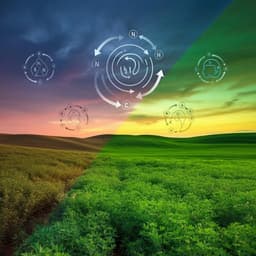
Environmental Studies and Forestry
Epipelagic nitrous oxide production offsets carbon sequestration by the biological pump
X. S. Wan, H. Sheng, et al.
This compelling study reveals how the marine biological pump's carbon sequestration efforts are challenged by the ocean's production of nitrous oxide, a potent greenhouse gas. Conducted by Xianhui S. Wan and collaborators, the research highlights how enhanced biological activity in the epipelagic zone increases nitrogen recycling and contributes significantly to nitrous oxide emissions, possibly offsetting climate benefits of carbon export.
~3 min • Beginner • English
Introduction
The ocean modulates atmospheric greenhouse gases by absorbing nearly 30% of anthropogenic CO2 while emitting about 20% of global N2O. The marine biological pump transports organic carbon from the surface to the ocean interior, regulating atmospheric CO2; however, its export efficiency is low in subtropical oligotrophic oceans, where most newly produced organic matter is remineralized in the epipelagic (upper ~200 m). N2O in the ocean is produced mainly via nitrification and denitrification pathways linked to organic matter supply and remineralization, but the shallow-water sources, pathways, and their coupling to primary productivity are not well constrained, partly due to light inhibition of ammonia oxidation and low abundance of ammonia-oxidizing archaea in surface waters. The study addresses the overlooked potential for epipelagic N2O production to offset the climate benefit of CO2 removal by the biological pump. The authors hypothesize that in subtropical oligotrophic oceans with inefficient export, N2O emissions associated with vigorous nitrogen recycling substantially counteract the radiative benefit of carbon export, and they aim to quantify shallow N2O production, identify its pathways, and relate it to carbon export.
Literature Review
Prior work shows N2O is produced as a by-product of nitrification and an intermediate in denitrification, with nitrification often dominant in oxygenated waters. Recent observations indicate more complex sources including nitrifier denitrification and denitrification within anoxic micro-niches on particles or in zooplankton guts, and a hybrid pathway in ammonia-oxidizing archaea where NH4+ and NO2− jointly contribute to N2O formation. Light inhibits ammonia oxidation in surface waters, complicating assessments of shallow sources. Geoengineering and nitrogen deposition studies suggested that N2O production could offset the radiative benefit of enhanced CO2 sequestration, but source partitioning and quantitative links between export production and N2O emissions remained unquantified. Long-term stations (ALOHA, BATS) and modeling/observational studies have constrained global oceanic N2O emissions and noted isotope signatures indicative of shallow N2O production, yet comprehensive evaluations of epipelagic sources across subtropical regions and their climate implications have been limited.
Methodology
Seven oceanographic cruises (2012–2019) sampled the South China Sea (SCS), the subtropical northwest Pacific (NWP), and the North Pacific Subtropical Gyre (NPSG), from coastal shelf to open ocean. High-resolution vertical profiles (0–200 m in open ocean; surface to bottom on shelf) were collected using a CTD rosette with 12-L Niskin bottles. Hydrographic (temperature, salinity, density), fluorescence, dissolved oxygen, and PAR were measured. Discrete samples were analyzed for nutrients (NH4+, NO2−, NO3−, Si(OH)4), particulate organic carbon (POC), particulate nitrogen (PN), and N2O concentrations and isotopes (δ15N, δ18O). Primary production was measured at selected stations via 13C-bicarbonate incubations (24 h, on-deck, light-controlled). Export production at 200 m was estimated using the 234Th deficit method with MnO2 co-precipitation and beta counting, with uranium inferred from salinity. N2O concentrations were determined by purge-and-trap GC-ECD (2012–2013) and by GC-IRMS with large-volume purge-and-trap (from 2014), cross-validated between methods. Dual isotopes of N2O were measured and calibrated against reference gases; precision for δ15N and δ18O was ~0.3–0.4‰. Air-sea N2O saturation and flux were computed using solubility (Henry’s law) and gas transfer velocity parameterized by wind speed and Schmidt number. To quantify N2O production pathways, on-deck dark incubations at near in situ temperature used 15N isotope tracers: 15NH4+, 15NO2−, and 15NO3−. Tracer additions (generally 300–1,000 nmol L−1, depending on depth and cruise) were made in 120-mL serum bottles. Time-series sampling enabled determination of ammonia oxidation (nitrification) rates (via 15NH4+ → NO2− + NO3−) and N2O production from each precursor (from increases in mass 44, 45, 46). Calculations accounted for single- and double-labeled N2O, isotope dilution, and atom fractions of substrate pools. Gross N2O production was the sum of NH4-, NO2-, and NO3-sourced rates. Detection limits were estimated from analytical precision, yielding ~0.04–0.16 nmol N L−1 d−1 for nitrification and 0.1–3.0 pmol N L−1 d−1 for N2O production depending on tracer. Isotope mass balance (two-endmember model) used δ15N and δ18O to estimate the fraction of shallow in situ N2O contributing to the isotope minimum layer relative to upward mixing from deeper concentration maxima. Statistical analyses included linear regressions between depth-integrated (0–200 m) N2O production and ammonia oxidation rates versus POC/PN inventories.
Key Findings
• Subtropical epipelagic waters showed low nutrients, high O2, low primary production (<1 µmol C L−1 d−1), and low export efficiencies (export ratio 3.9 ± 2.3%). Depth-integrated (0–125 m) primary production ranged 10.4 ± 0.4 to 44.1 ± 3.0 mmol C m−2 d−1; export at 200 m was 0.3 ± 0.1 to 2.0 ± 0.4 mmol C m−2 d−1. • Surface N2O was near to supersaturated (open ocean mean saturation 110 ± 6%; coastal/shelf 121 ± 6%). Air–sea N2O flux averaged 1.1 ± 0.6 µmol m−2 d−1 (open ocean) and 2.8 ± 0.9 µmol m−2 d−1 (shelf). • High-resolution profiles revealed sharp N2O concentration peaks (10–20 m thick) broadly co-located with the primary nitrite maximum (PNM) and NO3−/Si maximum, indicating localized production associated with intensive remineralization and nitrification. • Dual-isotope minima (δ15N-N2O and δ18O-N2O) near the PNM occurred at 12 of 15 stations, inconsistent with simple mixing and indicating widespread in situ shallow production. Minimum layers in the SCS were shallower (60–120 m) than previously noted at Station ALOHA (~300 m). • Isotope mass balance attributed a substantial fraction of air–sea N2O to shallow sources: 41.6 ± 21.0% by δ15N and 31.3 ± 11.0% by δ18O. • 15N tracer incubations showed multiple sources: N2O production from NH4+ and NO2− was common; NO3− reduction to N2O was occasionally detected, consistent with oxidative (nitrification), nitrifier-denitrification, and denitrification in micro-anoxic niches. • Depth-integrated gross N2O production (0–200 m) at open-ocean stations ranged 0.10 ± 0.02 to 0.57 ± 0.03 µmol m−2 d−1 (mean 0.28 ± 0.04), accounting for 29.5 ± 1.8% to 61.3 ± 6.4% of measured air–sea flux (mean 40.0 ± 7.7%). • Strong positive correlations were observed between depth-integrated N2O production and POC inventories, between ammonia oxidation and POC, and between ammonia oxidation and N2O production (significant linear regressions), implicating organic matter availability and nitrogen recycling in driving N2O production. • Estimated radiative offset: Using 100-year global warming potential (1 mol N2O ≈ 300 mol CO2), shallow N2O production offsets 5.6 ± 0.6% to 27.2 ± 6.7% (median ~8.8–9%) of the greenhouse warming mitigation from measured carbon export at studied SCS and NPSG stations. Site-specific offsets (Table 1) include K1: 9.1 ± 2.1%, X1: 8.5 ± 1.7%, A2: 27.2 ± 6.7%, SEATS: 5.6 ± 0.6%, A32: 6.2 ± 1.0%, Z2: 18.9 ± 2.4%.
Discussion
The findings support the hypothesis that vigorous nitrogen recycling in the epipelagic subtropical ocean produces substantial N2O that offsets the climate benefit of CO2 removal by the biological pump. The co-occurrence of N2O concentration and dual-isotope minima with the PNM and NO3−/Si maxima, along with tracer-derived production from NH4+, NO2−, and occasionally NO3−, demonstrates active shallow production via both oxidative and reductive pathways. The strong correlations of depth-integrated N2O production and ammonia oxidation with POC/PN inventories indicate that enhanced organic matter availability and particle-associated microenvironments fuel nitrogen transformations and N2O production. Because epipelagic remineralization is rapid and proximal to the atmosphere, a large fraction of N2O produced can ventilate on short timescales, while exported carbon is remineralized over varying depths and timescales, reducing long-term CO2 sequestration. Consequently, shallow N2O sources offset 6–27% (median ~9%) of the radiative benefit from observed carbon export in these subtropical systems. Considering ventilation ages and vertical attenuation of sinking particles, actual offsets may be larger where remineralization occurs above depths ventilated within 100 years. Ongoing ocean warming, enhanced stratification, and shifts toward smaller phytoplankton likely intensify epipelagic recycling, potentially increasing N2O production and further diminishing the net climate mitigation capacity of the biological pump.
Conclusion
Epipelagic N2O production in subtropical oceans is widespread, closely linked to organic matter remineralization and nitrogen recycling, and accounts for a substantial share of regional air–sea N2O flux. This shallow N2O source offsets a significant fraction (6–27%, median ~9%) of the climate benefit from carbon export by the marine biological pump, necessitating inclusion of N2O dynamics in assessments of the pump’s mitigation capacity. By combining high-resolution N2O concentration and isotope profiles with 15N tracer incubations, the study identifies multiple production pathways (oxidative and reductive) active in oxygenated epipelagic waters and quantifies their contributions. Future research should: (1) evaluate N2O/CO2 offsets across regions with differing export efficiencies and remineralization length-scales; (2) integrate particle-microenvironment processes and hybrid N2O pathways into biogeochemical and Earth system models; (3) resolve temporal variability and ventilation impacts on offsets; and (4) assess how climate-driven changes in stratification and plankton communities modulate epipelagic N2O production and the net climatic effect of the biological pump.
Limitations
Estimates are based on a limited number of stations and time points across the SCS, NWP, and NPSG, limiting extrapolation across broader spatial-temporal variability. Offset calculations involve uncertainties from differing timescales of particle remineralization and water mass ventilation, as well as assumptions in the two-endmember isotope mass balance. Tracer incubations may be affected by isotope dilution, substrate amendments exceeding in situ concentrations, and potential incubation artifacts that complicate precise partitioning among N2O pathways (e.g., hybrid production). The shallow contribution to air–sea flux inferred from isotopes and incubations carries propagated analytical uncertainties. Consequently, offsets reported likely represent conservative lower bounds for some settings.
Related Publications
Explore these studies to deepen your understanding of the subject.







